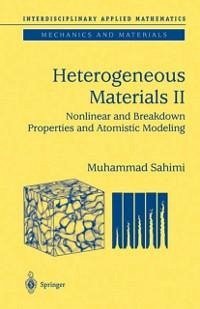This book describes and discusses the properties of heterogeneous materials. The properties considered include the conductivity (thermal, electrical, magnetic), elastic moduli, dielectrical constant, optical properties, mechanical fracture, and electrical and dielectrical breakdown properties. Both linear and nonlinear properties are considered. The nonlinear properties include those with constitutive nonlinearities as well as threshold nonlinearities, such as brittle fracture and dielectric breakdown.
A main goal of this book is to compare two fundamental approaches to describing and predicting materials properties, namely, the continuum mechanics approach and those based on the discrete models. The latter models include the lattice models and the atomistic approaches.
The book provides comprehensive and up-to-date theoretical and computer simulation analysis of materials properties. Typical experimental methods for measuring all of these properties are outlined, and comparison is made between the experimental data and the theoretical predictions. Volume I covers linear properties, while volume II considers nonlinear and fracture and breakdown properties, as well as atomistic modeling.
This multidisciplinary book will appeal to applied physicists, materials scientists, chemical and mechanical engineers, chemists, and applied mathematicians.
Muhammad Sahimi is Professor and Chairman of Chemical Engineering at the University of Southern California in Los Angeles, and Adjunct Professor of Physics at the Institute for Advanced Studies in Basic Sciences in Zanjan, Iran. His current research interests include transport and mechanical properties of heterogeneous materials: flow, diffusion and reaction in porous media, and large-scale scientific complications. Among his honors are the Alexander von Humbodt Foundation Research Award, and the Kapitza Gold Medal.
A main goal of this book is to compare two fundamental approaches to describing and predicting materials properties, namely, the continuum mechanics approach and those based on the discrete models. The latter models include the lattice models and the atomistic approaches.
The book provides comprehensive and up-to-date theoretical and computer simulation analysis of materials properties. Typical experimental methods for measuring all of these properties are outlined, and comparison is made between the experimental data and the theoretical predictions. Volume I covers linear properties, while volume II considers nonlinear and fracture and breakdown properties, as well as atomistic modeling.
This multidisciplinary book will appeal to applied physicists, materials scientists, chemical and mechanical engineers, chemists, and applied mathematicians.
Muhammad Sahimi is Professor and Chairman of Chemical Engineering at the University of Southern California in Los Angeles, and Adjunct Professor of Physics at the Institute for Advanced Studies in Basic Sciences in Zanjan, Iran. His current research interests include transport and mechanical properties of heterogeneous materials: flow, diffusion and reaction in porous media, and large-scale scientific complications. Among his honors are the Alexander von Humbodt Foundation Research Award, and the Kapitza Gold Medal.
Dieser Download kann aus rechtlichen Gründen nur mit Rechnungsadresse in A, B, BG, CY, CZ, D, DK, EW, E, FIN, F, GR, HR, H, IRL, I, LT, L, LR, M, NL, PL, P, R, S, SLO, SK ausgeliefert werden.
From the reviews: "There has been increasing interest in recent years in the synthesis and study of materials structured on the nanoscale and mesoscale. This two-volume treatment by Muhammad Sahimi of complex, disordered materials is thus particularly timely. ... The second volume also pays significant attention to fracture in heterogeneous materials. ... It is likely that this material will be of greatest interest to scientists in physics, engineering, chemistry, and materials science. ... well written in an accessible and readable style with detailed descriptions of the models ... ." (Ward H. Thompson, MRS Bulletin, Vol. 30, February, 2005) "The book is divided into two volumes. ... Volume II contains an extensive collection of nonlinear models, including models of fracture and breakdown and atomistic models. ... is well organized, contains necessary details and explanations and discusses predictions of the models ... . a useful contribution to the literature devoted to inhomogeneous materials. It can be recommended to a wide range of readers: from actively working investigators in the field ... to engineering students (as additional reading related to material science courses)." (Alexander G. Kolpakov, Mathematical Reviews, 2004e) "The second volume of this multidisciplinary book deals with the study of transport processes in nonlinear heterogeneous materials. One derives effective properties of disordered materials providing constitutive nonlinearities ... . This multidisciplinary book is recommended to materials scientists, chemical and mechanical engineers, and applied physicists and mathematicians." (Olivian Simionescu, Zentralblatt MATH, Vol. 1028, 2004) "The second volume of Sahimi's magnum opus deals with nonlinearities in the behavior of heterogenous materials. ... Apart from basic concepts and experimental techniques, the continuum and discrete approaches to fracture are considered in great detail. ... Sahimi's two books ... present an exhaustive account of the developments in heterogeneous materials research. They are outstanding contributions in the field." (Eva Gregorova, Materials World, Vol. 13 (12), 2005) "There has been increasing interest ... in the synthesis and study of materials structured on the nanoscale and mesoscale. This two-volume treatment by Muhammad Sahimi of complex, disordered materials is thus particularly timely. ... this material will be of greatest interest to scientists in physics, engineering, chemistry, and materials science. The books are well written in an accessible and readable style with detailed descriptions of the models and derivations of the theoretical approaches. ... useful for graduate students and researchers beginning in the field ... ." (Ward H. Thompson, MRS Bulletin, Vol. 30, February, 2005) "This book covers several major properties of heterogeneous materials ... . The book will be quite useful for engineers working on composite materials; it will allow them to look into not only the optical properties of these materials, but also their mechanical and thermal characteristics." (Hiroshi Mataki, Optics & Photonics News, Vol. 16 (10), 2005)

